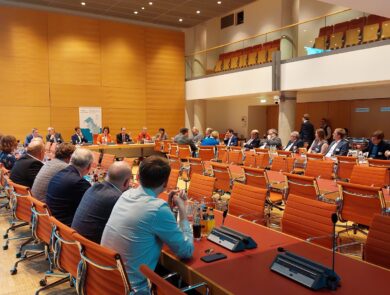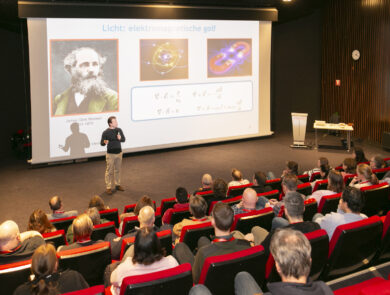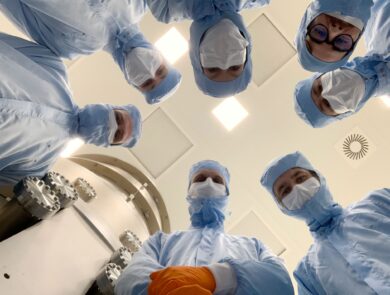Where Einstein Telescope meets optical fibre research

Between October 2021 and March 2022, a 250-metre-deep hole with a diameter of 10 cm was drilled near Cottessen. Its main purpose? To investigate the structure of the subsurface, and whether it would be quiet enough for the Einstein Telescope. To this end, a vibration sensor was placed at a depth of 250 metres. But when Nikhef-researcher Frank Linde met Rob Jansen of TNO, they came up with something else: this narrow well also offered the chance to test whether they could use a fibre optic cable as a sensor over its entire length. This sensor could measure temperature, deformation and vibrations. And this technology, in turn, can be useful for all kinds of applications.
Fibre optic cables are mainly used for telecom purposes. Rob Jansen however, is one of the people investigating other applications. Together with other research institutes and companies of the European project SLAM-DAST, he studies how they can use the cable itself as a sensor. Preferably a sensor that measures vibrations as well as temperature and deformation over its entire length. At this location, Jansens’s team focuses on vibrations.
“The sensor that was placed earlier, measures vibration at a depth of 250 metres. But we wanted to hang a fibre optic cable in the pipe, and see if we could measure vibrations every 3 metres.” Jansen explains. “This gives you much more insight into the various soil layers. Because every type of soil has a different effect on the transmission and reflection of vibrations. This technique is already being used in the oil and gas industry to make pictures of the subsurface. The application in Cottessen is unique. No oil or gas is produced here and it is a very quiet and peaceful location. We therefore hoped to achieve very low signal-to-noise levels here.”
Installing the cable
The installation of the fibre optic cable was not an easy task. First, two 198-metre cables that were connected at the bottom were hung in the tube. After this, the well was filled up with cement. This prevents water from reaching the sensors, which could interfere with the measurements. “The big unknown was how good the coupling of the fibre to the cement would be,” says Jansen. They didn’t know that beforehand.

First measurements
Fortunately, the coupling was good and the researchers could take the first measurements in March. The well turned out to be a good test location. As expected, there was much less noise in the well than in the lab and you could clearly see the effect of depth. The deeper the cable, the lower the signal-to noise level. They were also able to determine the deformation of the cable in the well. For instance, after cementing, about 60% less light passed through the cable and it was also deformed at a certain point. But the cause of this – a weak spot in the cement and in the pipe – was known and there is enough optic signal left to work with.
“These first tests,” says Jansen, “have given us a good insight into the current status of the well and can be considered as baseline measurements. When we take new measurements, we will be able to monitor any further deformation. As a result of subsidence for example, or further hardening of the cement.”
The researchers are also waiting for the results of the vibration sensor at the bottom of the narrow well. “We would like to compare the vibrations of the fibre optic cable to the vibrations of that sensor. It serves as a reference point. If you make this comparison, you can model pretty well which amplitudes and frequencies you can measure with the fibre optic cable.”
Possible applications of fibre optic sensing technology
The goal of the SLAM-DAST project is to apply multiple sensor technologies in the same fibre optic cable, to optimise this and to industrialise it so that it can be applied widely. It is expected to be used in, for example, ‘Structural Health Monitoring’: the monitoring of materials and technical constructions such as bridges, viaducts and pipelines. It can also be used for applications in the soil, such as measuring subsidence or detecting earthquakes.
From gravitational waves to fibre optic sensing
It was not the main objective when, under the banner of the E-TEST project, it was decided to drill a hole near Cottessen for preparatory research for the Einstein Telescope. But the new insights it could provide for fibre optic sensing are a nice by-product. Rob Jansen is pleased that this opportunity has arisen. “It is a unique test location where TNO can demonstrate and characterise the latest technological developments in the field of fibre optics. Together with the enthusiastic and expert team of Nikhef.” Frank Linde is also enthusiastic about the collaboration, which can also provide new insights for the Einstein Telescope: “I always like high-tech. Hopefully with this fibre we can determine the reduction of seismic noise as a function of depth. And that will contribute to a well-founded decision about at what depth the Einstein Telescope could be located.”
Read more:
- Website of the E-TEST project (opens in new window)
- Website of the SLAM-DAST project (opens in new window)


